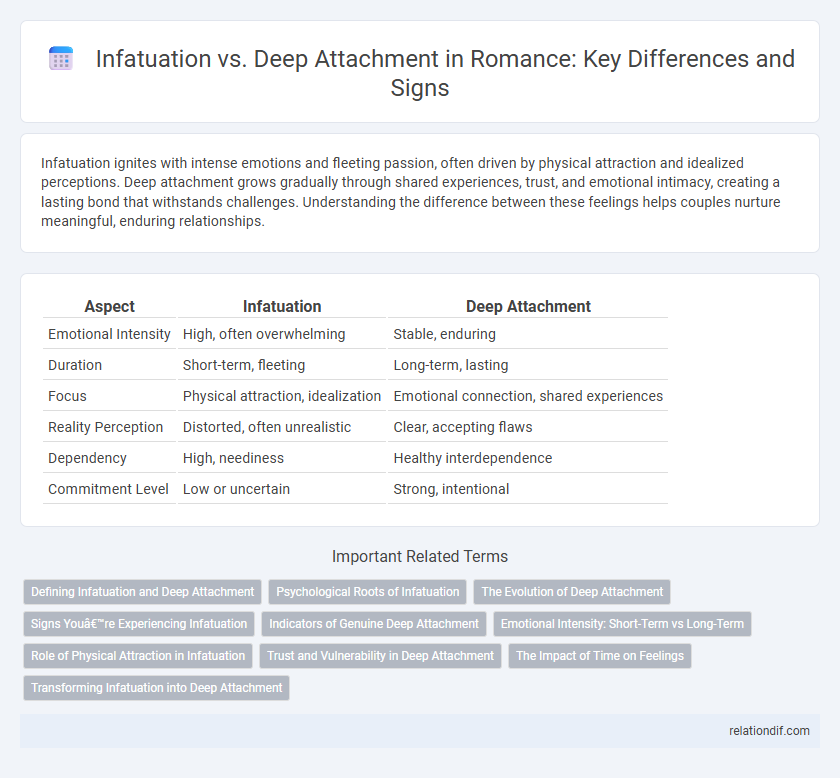Infatuation ignites with intense emotions and fleeting passion, often driven by physical attraction and idealized perceptions. Deep attachment grows gradually through shared experiences, trust, and emotional intimacy, creating a lasting bond that withstands challenges. Understanding the difference between these feelings helps couples nurture meaningful, enduring relationships.
Table of Comparison
| Aspect | Infatuation | Deep Attachment |
|---|---|---|
| Emotional Intensity | High, often overwhelming | Stable, enduring |
| Duration | Short-term, fleeting | Long-term, lasting |
| Focus | Physical attraction, idealization | Emotional connection, shared experiences |
| Reality Perception | Distorted, often unrealistic | Clear, accepting flaws |
| Dependency | High, neediness | Healthy interdependence |
| Commitment Level | Low or uncertain | Strong, intentional |
Defining Infatuation and Deep Attachment
Infatuation is characterized by intense but short-lived passion and idealization of a partner, often driven by physical attraction and emotional excitement. Deep attachment involves a stable, enduring bond based on trust, mutual respect, and emotional security that develops over time. While infatuation can fade quickly, deep attachment fosters lasting commitment and profound emotional connection.
Psychological Roots of Infatuation
Infatuation originates from heightened dopamine activity in the brain, triggering intense feelings of euphoria and obsession without a solid foundation of mutual understanding or emotional depth. This psychological state often involves idealizing the partner, overlooking flaws, and experiencing rapid emotional highs that differ fundamentally from deep attachment, which is grounded in oxytocin-driven bonding and long-term commitment. Unlike attachment, infatuation is characterized by urgency, emotional dependency, and a focus on surface-level attraction rather than the stability nurtured through shared experiences and trust.
The Evolution of Deep Attachment
Infatuation ignites with intense emotions and idealized perceptions that often fade quickly, while deep attachment evolves through shared experiences, trust, and emotional vulnerability over time. Neural pathways adapt as oxytocin and vasopressin promote bonding and long-term commitment, distinguishing deep attachment from fleeting passion. This progression fosters resilience in relationships, nurturing stability and mutual understanding beyond initial attraction.
Signs You’re Experiencing Infatuation
Rapid heartbeat, obsessive thoughts, and idealizing the person are key signs you're experiencing infatuation rather than deep attachment. Emotional intensity is high but often superficial, with feelings driven by physical attraction and fantasy. Unlike deep attachment, infatuation lacks the stability and long-term commitment seen in mature romantic bonds.
Indicators of Genuine Deep Attachment
Indicators of genuine deep attachment include consistent emotional support, unwavering trust, and the willingness to prioritize a partner's well-being over fleeting desires. Unlike infatuation, which often revolves around idealized fantasies and temporary excitement, deep attachment manifests through long-term commitment, open communication, and mutual respect. The presence of patience during conflicts and shared growth further distinguishes profound emotional bonds from superficial attraction.
Emotional Intensity: Short-Term vs Long-Term
Infatuation is marked by intense but fleeting emotions that often revolve around idealized perceptions of a partner, creating a high level of excitement and passion in a short span. Deep attachment involves sustained emotional intensity rooted in trust, mutual understanding, and shared experiences, fostering stability and security over time. Neuroscientific studies show infatuation activates reward pathways linked to dopamine surges, while deep attachment engages oxytocin and vasopressin pathways, supporting long-term bonding and emotional resilience.
Role of Physical Attraction in Infatuation
Physical attraction plays a crucial role in infatuation, often acting as the initial spark that captivates attention and ignites intense emotions. In contrast to deep attachment, which is grounded in emotional intimacy and trust, infatuation relies heavily on sensory stimuli such as appearance, scent, and touch to create a powerful but sometimes fleeting connection. Studies show that brain regions related to reward and motivation, like the ventral tegmental area, are highly active during infatuation, highlighting the biological basis of physical attraction in this early romantic phase.
Trust and Vulnerability in Deep Attachment
Deep attachment thrives on trust, allowing partners to embrace vulnerability without fear of judgment or betrayal. This emotional safety cultivates a lasting bond where individuals feel genuinely understood and accepted. Unlike infatuation's fleeting excitement, deep attachment builds resilience through shared honesty and mutual support.
The Impact of Time on Feelings
Infatuation often sparks intense emotions that peak quickly but tend to fade as time progresses, revealing superficial attraction rather than lasting connection. Deep attachment, by contrast, strengthens gradually through shared experiences and emotional intimacy, fostering long-term security and trust in relationships. The impact of time plays a critical role in transforming fleeting passion into profound love, highlighting the importance of sustained commitment for enduring romantic bonds.
Transforming Infatuation into Deep Attachment
Transforming infatuation into deep attachment requires moving beyond intense initial attraction to cultivate trust, emotional intimacy, and consistent support. Infatuation is often characterized by idealization and short-term passion, while deep attachment involves understanding flaws and building a secure emotional bond. Prioritizing vulnerability and open communication helps convert fleeting desire into lasting relational commitment.
infatuation vs deep attachment Infographic

 relationdif.com
relationdif.com